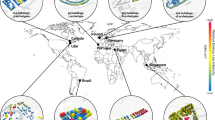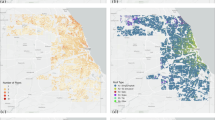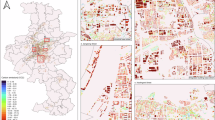Abstract
Achieving carbon neutrality is a critical yet elusive goal for many cities, hindered by limited understanding of the relationship between building emissions and their surroundings. To address this challenge, we present a generalizable open science framework that integrates building energy-consumption data, multi-modal geospatial inputs and graph deep learning to quantify building operating emissions and their links to urban form and socio-economic factors. Applying this approach to five cities with diverse climates and planning contexts—Melbourne, New York City (Manhattan), Seattle, Singapore and Washington DC—we demonstrate that our models explain 78.4% of the variation in building operating carbon emissions across cities, achieving state-of-the-art accuracy for urban-scale energy modelling. Our findings reveal strong connections between a city’s planning history and its building carbon profile, alongside stark inequalities where wealthier areas often exhibit the highest per capita emissions. Additionally, the relationship between urban density and building emissions is complex and city specific, with emissions extending beyond dense urban cores into suburban areas. To design effective decarbonization strategies, cities must consider how their planning histories, urban layouts and economic conditions shape current emissions patterns.
This is a preview of subscription content, access via your institution
Access options
Access Nature and 54 other Nature Portfolio journals
Get Nature+, our best-value online-access subscription
$32.99 / 30 days
cancel any time
Subscribe to this journal
Receive 12 digital issues and online access to articles
$119.00 per year
only $9.92 per issue
Buy this article
- Purchase on SpringerLink
- Instant access to full article PDF
Prices may be subject to local taxes which are calculated during checkout





Similar content being viewed by others
Data availability
The datasets in this study are publicly available as follows or can be obtained from Google Earth Engine. The benchmarking mandate data for each city are available at https://discover.data.vic.gov.au/dataset/property-level-energy-consumption-modelled-on-building-attributes-baseline-2011-and-b-2016-2026 (Melbourne), https://data.cityofnewyork.us/d/5zyy-y8am (NYC), https://data.seattle.gov/d/teqw-tu6e (Seattle), https://www1.bca.gov.sg/buildsg/sustainability/regulatory-requirements-for-existing-buildings/bca-building-energy-benchmarking-and-disclosure (Singapore) and https://opendata.dc.gov/maps/10f4f09fc5684d9988ae83ae4cca8b70 (Washington DC). The OpenStreetMap daily data extracts are available at https://www.geofabrik.de/data/download.html. The crowdsourced street view imagery can be obtained via Mapillary API with a registered developer key at https://www.mapillary.com/developer/api-documentation. Users can register for a Mapbox satellite imagery API access key at https://docs.mapbox.com/help/glossary/mapbox-satellite/. Global 3D building footprints are available via Zenodo at https://doi.org/10.5281/zenodo.15459025 (Americas, Africa and Oceania), https://doi.org/10.5281/zenodo.11397014 (Asia) and https://doi.org/10.5281/zenodo.11391076 (Europe) (ref. 65). The Meta High Resolution Population Density Maps are available at https://data.humdata.org/organization/meta?dataseries_name=Data+for+Good+at+Meta+-+High+Resolution+Population+Density+Maps+and+Demographic+Estimates. The Global Map of Local Climate Zone is available under Google Earth Engine API at https://developers.google.com/earth-engine/datasets/catalog/RUB_RUBCLIM_LCZ_global_lcz_map_latest.
Code availability
The analysis was conducted using Python. We provide accompanying datasets, download instructions and source code via Github at https://github.com/winstonyym/open-building-energy-prediction.
References
Tong, D. et al. Committed emissions from existing energy infrastructure jeopardize 1.5 °C climate target. Nature 572, 373–377 (2019).
IPCC Global Warming of 1.5 °C (eds Masson-Delmotte, V. et al.) (Cambridge Univ. Press, 2018).
Tracking Clean Energy Progress 2023 (IEA, 2023).
Hsu, A. et al. Climactor, harmonized transnational data on climate network participation by city and regional governments. Sci. Data 7, 374 (2020).
Net Zero Tracker. Net Zero Stocktake 2023 http://www.zerotracker.net/analysis/net-zero-stocktake-2023 (NewClimate Institute, Oxford Net Zero, Energy and Climate Intelligence Unit and Data-Driven EnviroLab, 2023).
Buildings (IEA, 2023).
Riahi, K. et al. Mitigation pathways compatible with long-term goals. in Climate Change 2022: Mitigation of Climate Change. Contribution of Working Group III to the Sixth Assessment Report of the Intergovernmental Panel on Climate Change (eds Shukla, P. R. et al.) Ch. 3 (Cambridge Univ. Press, 2022).
Arias, P. et al. in Climate Change 2021: The Physical Science Basis (eds Masson-Delmotte, V. et al.) 33–144 (Cambridge Univ. Press, 2021).
Seto, K. C. et al. in Climate Change 2014: Mitigation of Climate Change (eds Edenhofer, O. et al.) 923–1000 (Cambridge Univ. Press, 2015).
Hsu, A., Wang, X., Tan, J., Toh, W. & Goyal, N. Predicting european cities’ climate mitigation performance using machine learning. Nat. Commun. 13, 7487 (2022).
Ribeiro, H. V., Rybski, D. & Kropp, J. P. Effects of changing population or density on urban carbon dioxide emissions. Nat. Commun. 10, 3204 (2019).
Güneralp, B. et al. Global scenarios of urban density and its impacts on building energy use through 2050. Proc. Natl Acad. Sci. USA 114, 8945–8950 (2017).
Barrington-Leigh, C. & Millard-Ball, A. Global trends toward urban street-network sprawl. Proc. Natl Acad. Sci. USA 117, 1941–1950 (2020).
Georgescu, M., Morefield, P. E., Bierwagen, B. G. & Weaver, C. P. Urban adaptation can roll back warming of emerging megapolitan regions. Proc. Natl Acad. Sci. USA 111, 2909–2914 (2014).
Berrill, P., Wilson, E. J., Reyna, J. L., Fontanini, A. D. & Hertwich, E. G. Decarbonization pathways for the residential sector in the United States. Nat. Clim. Change 12, 712–718 (2022).
Shao, M., Wang, X., Bu, Z., Chen, X. & Wang, Y. Prediction of energy consumption in hotel buildings via support vector machines. Sustainable Cities Soc. 57, 102128 (2020).
To Create Net-Zero Cities, We Need to Look Hard at Our Older Buildings (World Economic Forum, 2022).
Zhao, X., Yin, Y., Zhang, S. & Xu, G. Data-driven prediction of energy consumption of district cooling systems (dcs) based on the weather forecast data. Sustainable Cities Soc. 90, 104382 (2023).
Reinhart, C. F. & Davila, C. C. Urban building energy modeling–a review of a nascent field. Building Environ. 97, 196–202 (2016).
Howard, B. et al. Spatial distribution of urban building energy consumption by end use. Energy Buildings 45, 141–151 (2012).
Mohammadi, N. & Taylor, J. E. Urban energy flux: spatiotemporal fluctuations of building energy consumption and human mobility-driven prediction. Appl. Energy 195, 810–818 (2017).
Yang, Y., Tan, Z. & Schläpfer, M. Assessing the space-use efficiency of french cities by coupling city volumes with mobile data traffic. Sustainable Cities Soc. 124, 106292 (2025).
Hong, T., Chen, Y., Luo, X., Luo, N. & Lee, S. H. Ten questions on urban building energy modeling. Building Environ. 168, 106508 (2020).
Chou, J.-S. & Tran, D.-S. Forecasting energy consumption time series using machine learning techniques based on usage patterns of residential householders. Energy 165, 709–726 (2018).
Streltsov, A., Malof, J. M., Huang, B. & Bradbury, K. Estimating residential building energy consumption using overhead imagery. Appl. Energy 280, 116018 (2020).
Dougherty, T. R., Huang, T., Chen, Y., Jain, R. K. & Rajagopal, R. Schmear: scalable construction of holistic models for energy analysis from rooftops. In Proc. 8th ACM International Conference on Systems for Energy-Efficient Buildings, Cities, and Transportation 111–120 (Association for Computing Machinery, 2021).
Biljecki, F. & Ito, K. Street view imagery in urban analytics and gis: a review. Landscape Urban Plann. 215, 104217 (2021).
Biljecki, F., Zhao, T., Liang, X. & Hou, Y. Sensitivity of measuring the urban form and greenery using street-level imagery: a comparative study of approaches and visual perspectives. Int. J. Appl. Earth Obs. Geoinf. 122, 103385 (2023).
Zhang, F. et al. Urban visual intelligence: studying cities with artificial intelligence and street-level imagery. Ann. Am. Assoc. Geogr. https://doi.org/10.1080/24694452.2024.2313515 (2024).
Sun, M. et al. Understanding building energy efficiency with administrative and emerging urban big data by deep learning in glasgow. Energy Buildings 273, 112331 (2022).
Mayer, K. et al. Estimating building energy efficiency from street view imagery, aerial imagery, and land surface temperature data. Appl. Energy 333, 120542 (2023).
Sun, M. & Bardhan, R. Identifying hard-to-decarbonize houses from multi-source data in Cambridge, UK. Sustainable Cities Soc. 100, 105015 (2024).
Yap, W. & Biljecki, F. A global feature-rich network dataset of cities and dashboard for comprehensive urban analyses. Sci. Data 10, 667 (2023).
Hou, Y. et al. Global streetscapes—a comprehensive dataset of 10 million street-level images across 688 cities for urban science and analytics. ISPRS J. Photogramm. Remote Sens. 215, 216–238 (2024).
Goldstein, B., Gounaridis, D. & Newell, J. P. The carbon footprint of household energy use in the United States. Proc. Natl Acad. Sci. USA 117, 19122–19130 (2020).
de Chalendar, J. A., Taggart, J. & Benson, S. M. Tracking emissions in the US electricity system. Proc. Natl Acad. Sci. USA 116, 25497–25502 (2019).
To Meet Our Global Climate Ambitions, We Must Tackle Embodied Carbon (World Economic Forum, 2024).
2021 Global Status Report for Buildings and Construction (Global Alliance for Buildings and Construction, 2021).
Buildings. NYC Mayor's Office of Climate and Environmental Justice https://climate.cityofnewyork.us/subtopics/buildings/ (2024).
Timmons, D., Zirogiannis, N. & Lutz, M. Location matters: population density and carbon emissions from residential building energy use in the united states. Energy Res. Social Sci. 22, 137–146 (2016).
Gudipudi, R., Fluschnik, T., Ros, A. G. C., Walther, C. & Kropp, J. P. City density and CO2 efficiency. Energy Policy 91, 352–361 (2016).
Chen, J. et al. Global 1 km × 1 km gridded revised real gross domestic product and electricity consumption during 1992–2019 based on calibrated nighttime light data. Sci. Data 9, 202 (2022).
Fox, S., Agyemang, F., Hawker, L. & Neal, J. Integrating social vulnerability into high-resolution global flood risk mapping. Nat. Commun. 15, 3155 (2024).
Jaganathan, S. et al. Estimating the effect of annual PM2.5 exposure on mortality in India: a difference-in-differences approach. Lancet Planet. Health 8, e987–e996 (2024).
Creutzig, F., Baiocchi, G., Bierkandt, R., Pichler, P.-P. & Seto, K. C. Global typology of urban energy use and potentials for an urbanization mitigation wedge. Proc. Natl Acad. Sci. USA 112, 6283–6288 (2015).
Jones, C. & Kammen, D. M. Spatial distribution of US household carbon footprints reveals suburbanization undermines greenhouse gas benefits of urban population density. Environ. Sci. Technol. 48, 895–902 (2014).
The Paris Agreement (UNFCC, 2015).
Moore, F. C. et al. Determinants of emissions pathways in the coupled climate–social system. Nature 603, 103–111 (2022).
Yu, Y. et al. Decarbonization efforts hindered by china’s slow progress on electricity market reforms. Nat. Sustainability 6, 1006–1015 (2023).
Dong, L. et al. Defining a city—delineating urban areas using cell-phone data. Nat. Cities 1, 117–125 (2024).
Pisello, A. L., Taylor, J. E., Xu, X. & Cotana, F. Inter-building effect: simulating the impact of a network of buildings on the accuracy of building energy performance predictions. Building Environ. 58, 37–45 (2012).
Li, Y., Schubert, S., Kropp, J. P. & Rybski, D. On the influence of density and morphology on the urban heat island intensity. Nat. Commun. 11, 2647 (2020).
Gao, J. & Bukovsky, M. S. Urban land patterns can moderate population exposures to climate extremes over the 21st century. Nat. Commun. 14, 6536 (2023).
Hou, H., Su, H., Yao, C. & Wang, Z.-H. Spatiotemporal patterns of the impact of surface roughness and morphology on urban heat island. Sustainable Cities Soc. 92, 104513 (2023).
Ritchie, H., Roser, M. & Rosado, P. CO2 and Greenhouse Gas Emissions (Our World in Data, 2020).
Hsu, A., Sheriff, G., Chakraborty, T. & Manya, D. Disproportionate exposure to urban heat island intensity across major us cities. Nat. Commun. 12, 2721 (2021).
Batty, M. Cities as Complex Systems: Scaling, Interaction, Networks, Dynamics and Urban Morphologies (Springer, 2009).
Barthélemy, M. Spatial networks. Phys. Rep. 499, 1–101 (2011).
Yap, W., Stouffs, R. & Biljecki, F. Urbanity: automated modelling and analysis of multidimensional networks in cities. Npj Urban Sustainability 3, 45 (2023).
Stewart, I. D. & Oke, T. R. Local climate zones for urban temperature studies. Bull. Am. Meteorolog. Soc. 93, 1879–1900 (2012).
Demuzere, M. et al. A global map of local climate zones to support earth system modelling and urban scale environmental science. Earth Syst. Sci. Data Discuss. 2022, 1–57 (2022).
Yang, Q. et al. A global urban heat island intensity dataset: generation, comparison, and analysis. Remote Sens. Environ. 312, 114343 (2024).
Cheng, B., Misra, I., Schwing, A. G., Kirillov, A. & Girdhar, R. Masked-attention mask transformer for universal image segmentation. In Proc. IEEE/CVF Conference on Computer Vision and Pattern Recognition 1290–1299 (IEEE, 2022).
Facebook Connectivity Lab and Center for International Earth Science Information Network—High Resolution Settlement Layer (HRSL) (CIESIN, 2016).
Che, Y. et al. 3D-GloBFP: the first global three-dimensional building footprint dataset. Earth Syst. Sci. Data Discuss. 2024, 1–28 (2024).
Hamilton, W., Ying, Z. & Leskovec, J. Inductive representation learning on large graphs. In 31st Conference on Neural Information Processing Systems (NIPS 2017) https://proceedings.neurips.cc/paper_files/paper/2017/file/5dd9db5e033da9c6fb5ba83c7a7ebea9-Paper.pdf (NIPS, 2017).
Yang, S., Chong, A., Liu, P. & Biljecki, F. Thermal comfort in sight: thermal affordance and its visual assessment for sustainable streetscape design. Building Environ. 112569 (2025).
Song, C. et al. Developing urban building energy models for shanghai city with multi-source open data. Sustainable Cities Soc. 106, 105425 (2024).
Biljecki, F. & Chow, Y. S. Global building morphology indicators. Comput. Environ. Urban Syst. 95, 101809 (2022).
Fey, M. & Lenssen, J. E. Fast graph representation learning with PyTorch geometric. In International Conference on Learning Representations https://rlgm.github.io/papers/2.pdf (2019).
Statistical Review of World Energy (Energy Institute, 2024); https://www.energyinst.org/statistical-review
Acknowledgements
We thank the members of the National University of Singapore (NUS) Urban Analytics Lab for the discussions. W.Y. thankfully acknowledges the NUS Graduate Research Scholarship granted by the National University of Singapore. This research is part of the project Large-scale 3D Geospatial Data for Urban Analytics, which is supported by the National University of Singapore under the Start-Up Grant R-295-000-171-133.
Author information
Authors and Affiliations
Contributions
W.Y.: methodology conceptualization and design, conceived study, methodology development, data acquisition and analysis, data testing and validation, wrote original manuscript. A.N.W.: methodology conceptualization and design, conceived study, revised and reviewed manuscript. C.M.: methodology conceptualization and design, revised and reviewed manuscript. F.B. methodology conceptualization and design, revised and reviewed manuscript, research supervision, project funding.
Corresponding author
Ethics declarations
Competing interests
The authors declare no competing interests.
Peer review
Peer review information
Nature Sustainability thanks Gunther Gust, Fan Zhang and the other, anonymous, reviewer(s) for their contribution to the peer review of this work.
Additional information
Publisher’s note Springer Nature remains neutral with regard to jurisdictional claims in published maps and institutional affiliations.
Supplementary information
Supplementary information
Supplementary Figs. 1 and 2 and Tables 1–6.
Rights and permissions
Springer Nature or its licensor (e.g. a society or other partner) holds exclusive rights to this article under a publishing agreement with the author(s) or other rightsholder(s); author self-archiving of the accepted manuscript version of this article is solely governed by the terms of such publishing agreement and applicable law.
About this article
Cite this article
Yap, W., Wu, A.N., Miller, C. et al. Revealing building operating carbon dynamics for multiple cities. Nat Sustain (2025). https://doi.org/10.1038/s41893-025-01615-8
Received:
Accepted:
Published:
DOI: https://doi.org/10.1038/s41893-025-01615-8



